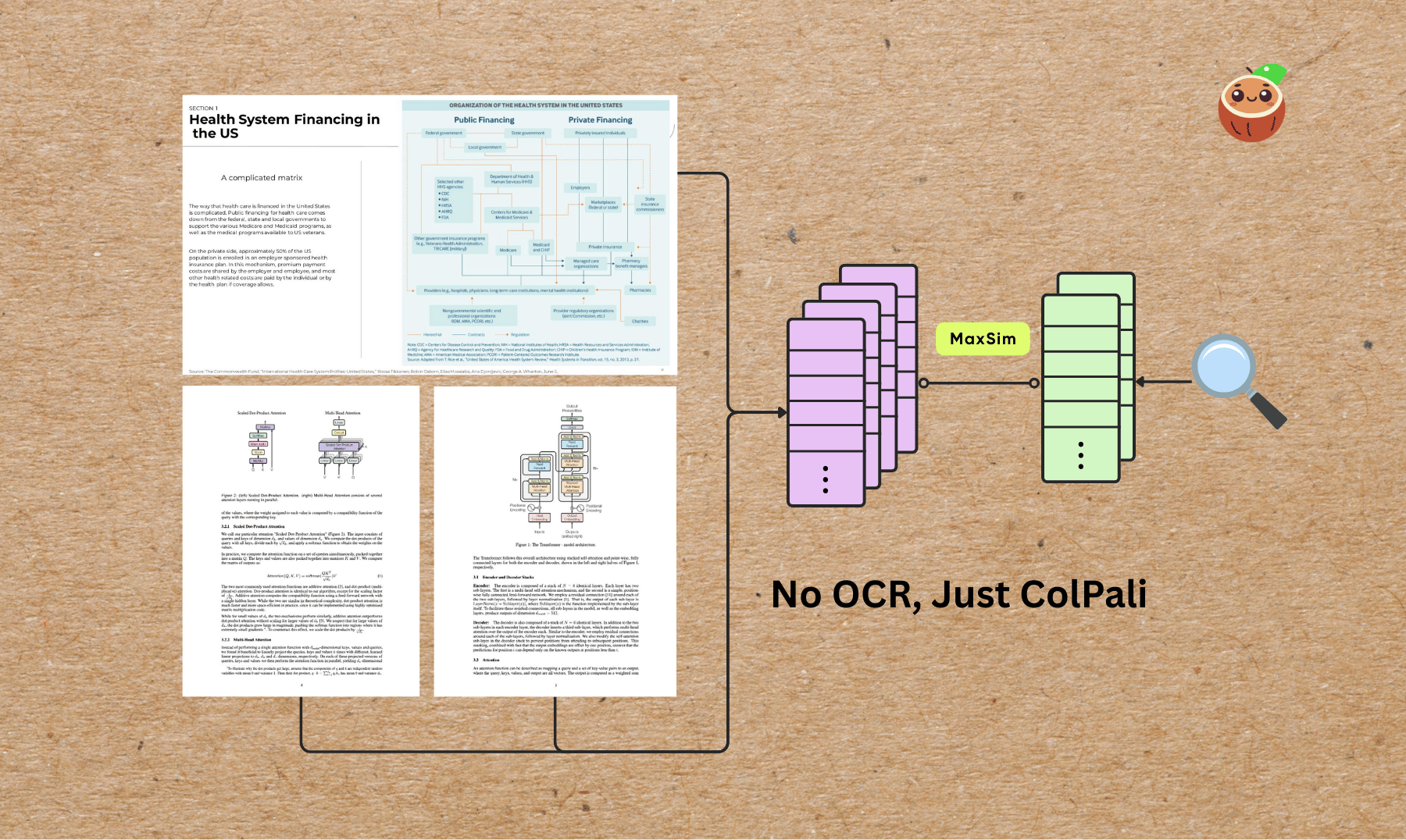Do you have a messy collection of scanned documents, PDFs, academic papers, presentation slides, and standalone images — all mixed together with charts, tables, and figures — that you want to process into the same vector space for semantic search or to power an AI agent?
In this example, we’ll walk through how to build a visual document indexing pipeline using ColPali for embedding both PDFs and images — and then query the index using natural language.We’ll skip OCR entirely — ColPali can directly understand document layouts, tables, and figures from images, making it perfect for semantic search across visual-heavy content.
If this helps you, ⭐ Star CocoIndex GitHub!
Use Cases
- Semantic search across scanned documents and visual-heavy reports
- Searching tables, charts, or diagrams without OCR
- Cross-modal search (e.g., “find the page showing a bar chart about Q2 revenue”)
- Research paper figure indexing
- Historical archive search without text extraction
Flow Overview
We’ll build a pipeline that:
- Ingests PDFs and images from a local directory
- Converts PDF pages into high-resolution images (300 DPI)
- Generates visual embeddings for each page/image using ColPali
- Stores embeddings + metadata in a Qdrant vector database
- Supports natural language queries directly against the visual index
Example queries:
- "handwritten lab notes about physics"
- "architectural floor plan with annotations"
- "pie chart of Q3 revenue"
Full code is open source and available here. 🚀 Only ~70 lines of Python on the indexing path (super simple!)
Core Components
Image Ingestion
We use CocoIndex’s LocalFile source to read PDFs and images:
data_scope["documents"] = flow_builder.add_source(
cocoindex.sources.LocalFile(path="source_files", binary=True)
)
Convert Files to Pages
We classify files by MIME type and process accordingly.
Define a dataclass:
page_number: The page number (if applicable — only for PDFs)image: The binary content of that page as a PNG image
@dataclass
class Page:
page_number: int | None
image: bytes
Normalizes different file formats into a list of page images so the rest of the pipeline can process them uniformly. This file_to_pages function takes a filename and its raw binary content (bytes) and returns a list of Page objects, where each Page contains:
@cocoindex.op.function()
def file_to_pages(filename: str, content: bytes) -> list[Page]:
mime_type, _ = mimetypes.guess_type(filename)
if mime_type == "application/pdf":
images = convert_from_bytes(content, dpi=300)
pages = []
for i, image in enumerate(images):
with BytesIO() as buffer:
image.save(buffer, format="PNG")
pages.append(Page(page_number=i + 1, image=buffer.getvalue()))
return pages
elif mime_type and mime_type.startswith("image/"):
return [Page(page_number=None, image=content)]
else:
return []
For each document:
- If the file is an image →
file_to_pagesreturns a singlePagewherepage["image"]is just the original image binary. - If the file is a PDF →
file_to_pagesconverts each page to a PNG, sopage["image"]contains that page’s PNG binary.
In the flow we convert all the files to pages. this makes each pages and all images in the output data - pages.
output_embeddings = data_scope.add_collector()
with data_scope["documents"].row() as doc:
doc["pages"] = flow_builder.transform(
file_to_pages, filename=doc["filename"], content=doc["content"]
)
Generate Visual Embeddings
We use ColPali to generate embeddings for images on each page.
with doc["pages"].row() as page:
page["embedding"] = page["image"].transform(
cocoindex.functions.ColPaliEmbedImage(model=COLPALI_MODEL_NAME)
)
output_embeddings.collect(
id=cocoindex.GeneratedField.UUID,
filename=doc["filename"],
page=page["page_number"],
embedding=page["embedding"],
)
ColPali Architecture fundamentally rethinks how documents, especially visually complex or image-rich ones, are represented and searched. Instead of reducing each image or page to a single dense vector (as in traditional bi-encoders), ColPali breaks an image into many smaller patches, preserving local spatial and semantic structure.
Each patch receives its own embedding, which together form a multi-vector representation of the complete document.
For a detailed explanation of ColPali Architecture, please refer to our previous blog with image search examples.
Collect & Export to Qdrant
Note the way to embed image and query are different, as they’re two different types of data.
Create a function to embed query:
@cocoindex.transform_flow()
def query_to_colpali_embedding(
text: cocoindex.DataSlice[str],
) -> cocoindex.DataSlice[list[list[float]]]:
return text.transform(
cocoindex.functions.ColPaliEmbedQuery(model=COLPALI_MODEL_NAME)
)
We store metadata and embeddings in Qdrant:
output_embeddings.export(
"multi_format_indexings",
cocoindex.targets.Qdrant(
connection=qdrant_connection,
collection_name=QDRANT_COLLECTION,
),
primary_key_fields=["id"],
)
Query the Index
ColPali supports text-to-visual embeddings, so we can search using natural language:
query_embedding = query_to_colpali_embedding.eval(query)
search_results = client.query_points(
collection_name=QDRANT_COLLECTION,
query=query_embedding,
using="embedding",
limit=5,
with_payload=True,
)
Checkout the full code here.
Debugging with CocoInsight
Run CocoInsight locally:
cocoindex server -ci main.py
Open https://cocoindex.io/cocoinsight to:
- View extracted pages
- See embedding vectors and metadata
Support Us
We’re constantly adding more examples and improving our runtime.
⭐ Star CocoIndex on GitHub and share the love ❤️!
And let us know what are you building with CocoIndex — we’d love to feature them.


